Comparative Study of Ramp-Rate Control Algorithms for PV with Energy Storage Systems
Abstract
:1. Introduction
2. Power Smoothing Methods
2.1. Moving Average (MA)
2.2. Exponential Moving Average (EMA)
2.3. First Order Low-Pass Filter (LPF)
2.4. Second Order Low-Pass Filter (2-LPF)
3. Methodology
3.1. Comparison and Assumptions
- Ability to limit the RR to 10% per minute of the rated power,
- Battery SOC level and status at end of the day,
- Battery energy level,
- Battery Cycles.
- The DC/DC converters and inverter are simulated as average models, since the focus of this work is not in the dynamic response.
- The PV array considers a constant temperature, invariant during the system operation.
- The battery capacitance is treated as constant during the system simulation. This is considered as the degradation in the battery capacitance is not significant for a 1-day operation.
- The effect of the temperature is not taken into account on the battery model.
3.2. System Description
3.3. Analysis Conditions
3.3.1. Irradiance Profile
3.3.2. Ramp-Rate Calculation
4. Results
4.1. Power Smoothing Evaluation
4.1.1. Moving Average (MA)
4.1.2. Exponential Moving Average (EMA)
4.1.3. First Order Low-Pass Filter (LPF)
4.1.4. Second Order Low-Pass Filter (2-LPF)
4.2. Energy and Power Exchange with Battery
4.3. Battery Cycles
4.4. Lifetime Analysis
5. Conclusions
Author Contributions
Funding
Conflicts of Interest
References
- Tsao, R. Strong Chinese Market to Push Annual Global Photovoltaic Demand Above 100 Gigawatts for 2017. 20 January 2018. Available online: https://press.trendforce.com/press/20170914-2962.html (accessed on 8 April 2019).
- Yang, X.J.; Hu, H.; Tan, T.; Li, J. China’s renewable energy goals by 2050. Environ. Dev. 2016, 20, 83–90. [Google Scholar] [CrossRef]
- Yang, Y.; Enjeti, P.; Blaabjerg, F.; Wang, H. Wide-scale adoption of photovoltaic energy: Grid code modifications are explored in the distribution grid. IEEE Ind. Appl. Mag. 2015, 21, 21–31. [Google Scholar] [CrossRef]
- Energinet.dk. Technical Regulation 3.2.2 for PV Power Plants with a Power Output Above 11 kW; Energinet.dk: Denmark, 2015; pp. 1–96. Available online: https://en.energinet.dk/Electricity/Rules-and-Regulations/Regulations-for-grid-connection (accessed on 8 April 2019).
- Booth, S.; Gevorgian, V. Review of PREPA Technical Requirements for Interconnecting Wind and Solar Generation; National Renewable Energy Laboratory: Golden, CO, USA, 2013.
- BDEW Bundesverband der Energie- und Wasserwirtschaft e.V. Technische Richtlinie, Erzeugungsanlagen Am Mittelspannungsnetz; BDEW: Germany, June 2008; p. 138. Available online: https://www.bonn-netz.de/Einspeisung/Vertraege/Stromeinspeisevertraege/Anlage-3-Technische-Richtlinien-Erzeugungsanlagen-am-Mittelspannungsnetz.pdf (accessed on 8 April 2019).
- Energinet.dk. Technical Regulation 3.2.2 for PV Power Plants Above 11 kW; Energinet.dk: Denmark, 2016; pp. 1–108. Available online: https://en.energinet.dk/Electricity/Rules-and-Regulations/Regulations-for-grid-connection (accessed on 8 April 2019).
- Sangwongwanich, A.; Yang, Y.; Blaabjerg, F. A cost-effective power ramp-rate control strategy for single-phase two-stage grid-connected photovoltaic systems. In Proceedings of the 2016 IEEE Energy Conversion Congress and Exposition (ECCE), Milwaukee, WI, USA, 18–22 September 2016. [Google Scholar]
- Omran, W.A.; Kazerani, M.; Salama, M.M.A. Investigation of Methods for Reduction of Power Fluctuations Generated From Large Grid-Connected Photovoltaic Systems. IEEE Trans. Energy Convers. 2011, 26, 318–327. [Google Scholar] [CrossRef]
- Ina, N.; Yanagawa, S.; Kato, T.; Suzuoki, Y. Smoothing of PV system output by tuning MPPT control. Electr. Eng. Jpn. 2005, 152, 10–17. [Google Scholar] [CrossRef]
- Chen, J.; Li, J.; Zhang, Y.; Bao, G.; Ge, X.; Li, P. A Hierarchical Optimal Operation Strategy of Hybrid Energy Storage System in Distribution Networks with High Photovoltaic Penetration. Energies 2018, 11, 389. [Google Scholar] [CrossRef]
- Chediak, M. The Latest Bull Case for Electric Cars: The Cheapest Batteries Ever; Bloomberg Technology. 2017. Available online: https://www.bloomberg.com/news/articles/2018-07-13/wework-tells-employees-meat-is-permanently-off-the-company-menu (accessed on 5 April 2019).
- Xu, X.; Casale, E.; Bishop, M.; Oikarinen, D. Application of new generic models for PV and battery storage in system planning studies. In Proceedings of the Power & Energy Society General Meeting, Chicago, IL, USA, 16–20 July 2017. [Google Scholar]
- Faessler, B.; Schuler, M.; Preibinger, M.; Kepplinger, P. Battery Storage Systems as Grid-Balancing Measure in Low-Voltage Distribution Grids with Distributed Generation. Energies 2017, 10, 2161. [Google Scholar] [CrossRef]
- Hund, T.D.; Gonzalez, S.; Barrett, K. Grid-tied PV system energy smoothing. In Proceedings of the 2010 35th IEEE Photovoltaic Specialists Conference, Honolulu, HI, USA, 20–25 June 2010; pp. 2762–2766. [Google Scholar]
- Ellis, A.; Schoenwald, D.; Hawkins, J.; Willard, S.; Arellano, B. PV output smoothing with energy storage. In Proceedings of the 2012 38th IEEE Photovoltaic Specialists Conference, Austin, TX, USA, 3–8 June 2012; pp. 1523–1528. [Google Scholar]
- Tesfahunegn, S.G.; Ulleberg, Ø.; Vie, P.J.S.; Undeland, T.M. PV fluctuation balancing using hydrogen storage—A smoothing method for integration of PV generation into the utility grid. Energy Procedia 2011, 12, 1015–1022. [Google Scholar] [CrossRef]
- Liu, H.; Peng, J.; Zang, Q.; Yang, K. Control Strategy of Energy Storage for Smoothing Photovoltaic Power Fluctuations. IFAC-PapersOnLine 2015, 48, 162–165. [Google Scholar] [CrossRef]
- Nikolov, D.N. Power Ramp Rate Reduction in Photovoltaic Power Plants Using Energy Storage. Master’s Thesis, Aalborg University, Aalborg, Denmark, 2017. [Google Scholar]
- Alam, M.J.E.; Muttaqi, K.M.; Sutanto, D. A novel approach for ramp-rate control of solar PV using energy storage to mitigate output fluctuations caused by cloud passing. IEEE Trans. Energy Convers. 2014, 29, 507–518. [Google Scholar]
- Stroe, D. Lifetime Models for Lithium Ion Batteries Used in Virtual Power Plants. Ph.D. Thesis, Aalborg University, Aalborg, Denmark, September 2014. [Google Scholar]
- Kakimoto, N.; Satoh, H.; Takayama, S.; Nakamura, K. Ramp-rate control of photovoltaic generator with electric double-layer capacitor. IEEE Trans. Energy Convers. 2009, 24, 465–473. [Google Scholar] [CrossRef]
- Puri, A. Optimally smoothing output of PV farms. In Proceedings of the 2014 IEEE PES General Meeting|Conference & Exposition, National Harbor, MD, USA, 27–31 July 2014. [Google Scholar]
- Sera, D. Real-Time Modelling, Diagnostics and Optimised MPPT for Residental PV Systems; Aalborg University: Aalborg, Denmark, 2009. [Google Scholar]
- Hohm, D.P.; Ropp, M.E. Comparative study of maximum power point tracking algorithms using an experimental, programmable, maximum power point tracking test bed. In Proceedings of the Conference Record of the Twenty-Eighth IEEE Photovoltaic Specialists Conference, Anchorage, AK, USA, 15–22 September 2000; pp. 1699–1702. [Google Scholar]
- Spataru, S.; Martins, J.; Stroe, D.; Sera, D. Test Platform for Photovoltaic Systems with Integrated Battery Energy Storage Applications. In Proceedings of the 2018 IEEE 7th World Conference on Photovoltaic Energy Conversion (WCPEC), Waikoloa Village, HI, USA, 10–15 June 2018; pp. 2–7. [Google Scholar]
- Tremblay, O.; Dessaint, L.-A. Experimental validation of a battery dynamic model for EV applications. World Electr. Veh. J. 2009, 3, 289–298. [Google Scholar] [CrossRef]
- Shepherd, C.M. Design of primary and secondary cells II. An equation describing battery discharge. J. Electrochem. Soc. 1965, 112, 657–664. [Google Scholar] [CrossRef]
- Moghaddam, I.; Chowdhury, B. Battery Energy Storage Sizing With Respect to PV-induced Power Ramping Concerns in Distribution Networks. In Proceedings of the 2017 IEEE Power & Energy Society General Meeting, Chicago, IL, USA, 16–20 July 2017; Volume 5. [Google Scholar]
- Panasonic. Lithium Ion UR18650WX, 2012. Available online: https://na.industrial.panasonic.com/sites/default/pidsa/files/ur18650wx4.pdf (accessed on 7 April 2019).
- Lave, M.; Broderick, R.J.; Reno, M.J. Solar variability zones: Satellite-derived zones that represent high-frequency ground variability. Sol. Energy 2017, 151, 119–128. [Google Scholar] [CrossRef]
- Amzallag, C.; Gerey, J.P.; Robert, J.L.; Bahuaud, J. Standardization of the rainflow counting method for fatigue analysis. Int. J. Fatigue 1994, 16, 287–293. [Google Scholar] [CrossRef]
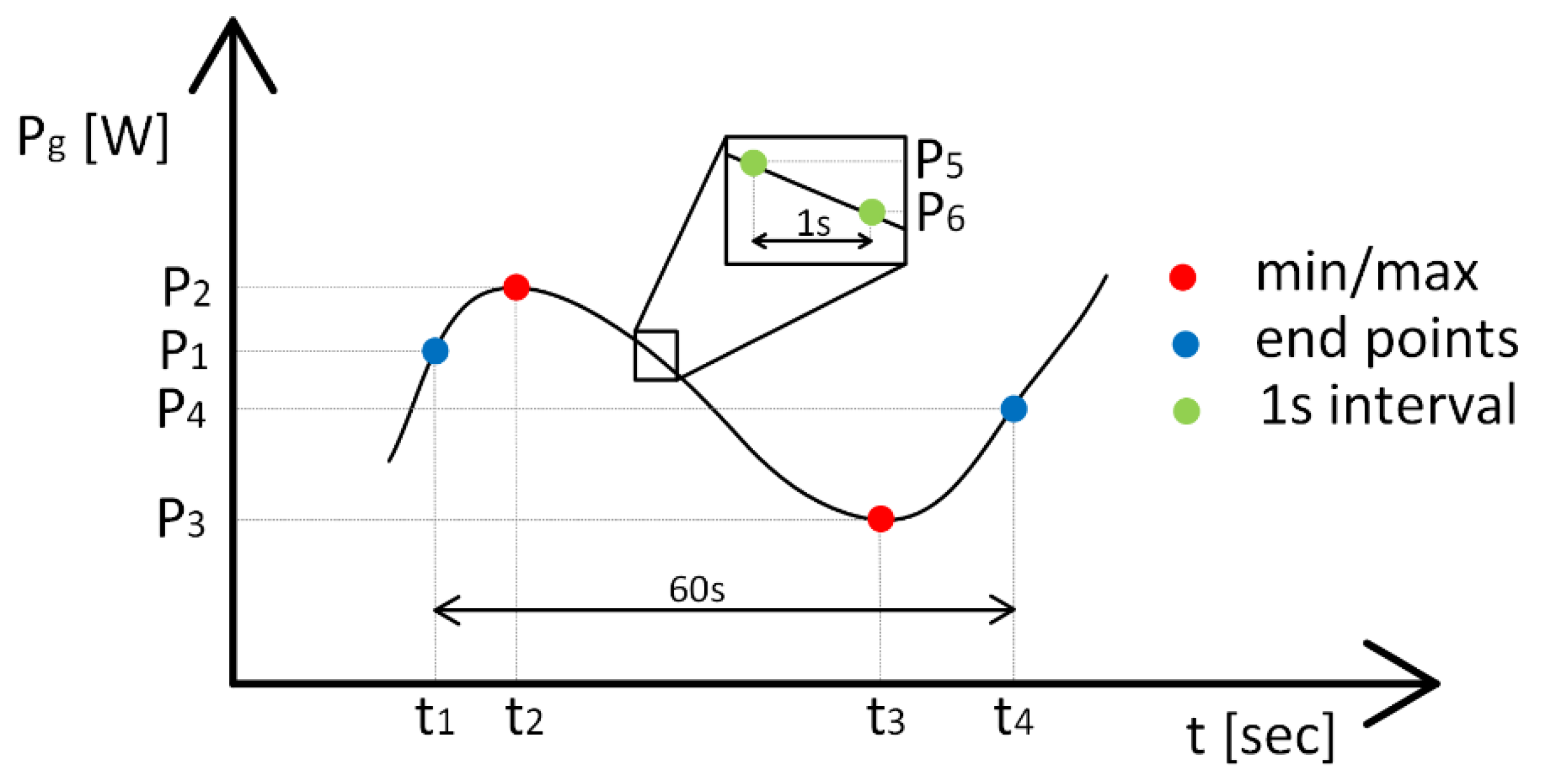
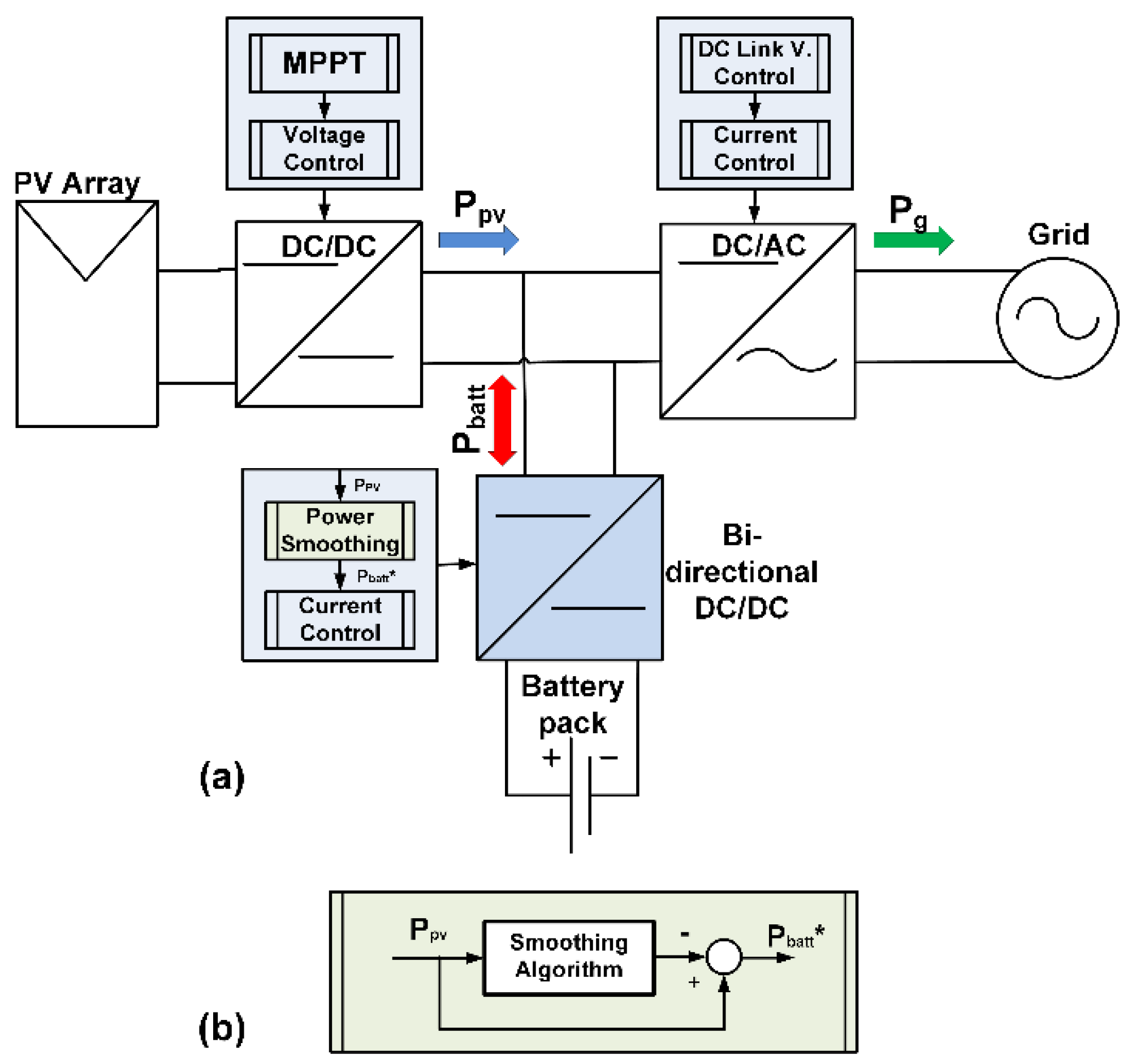
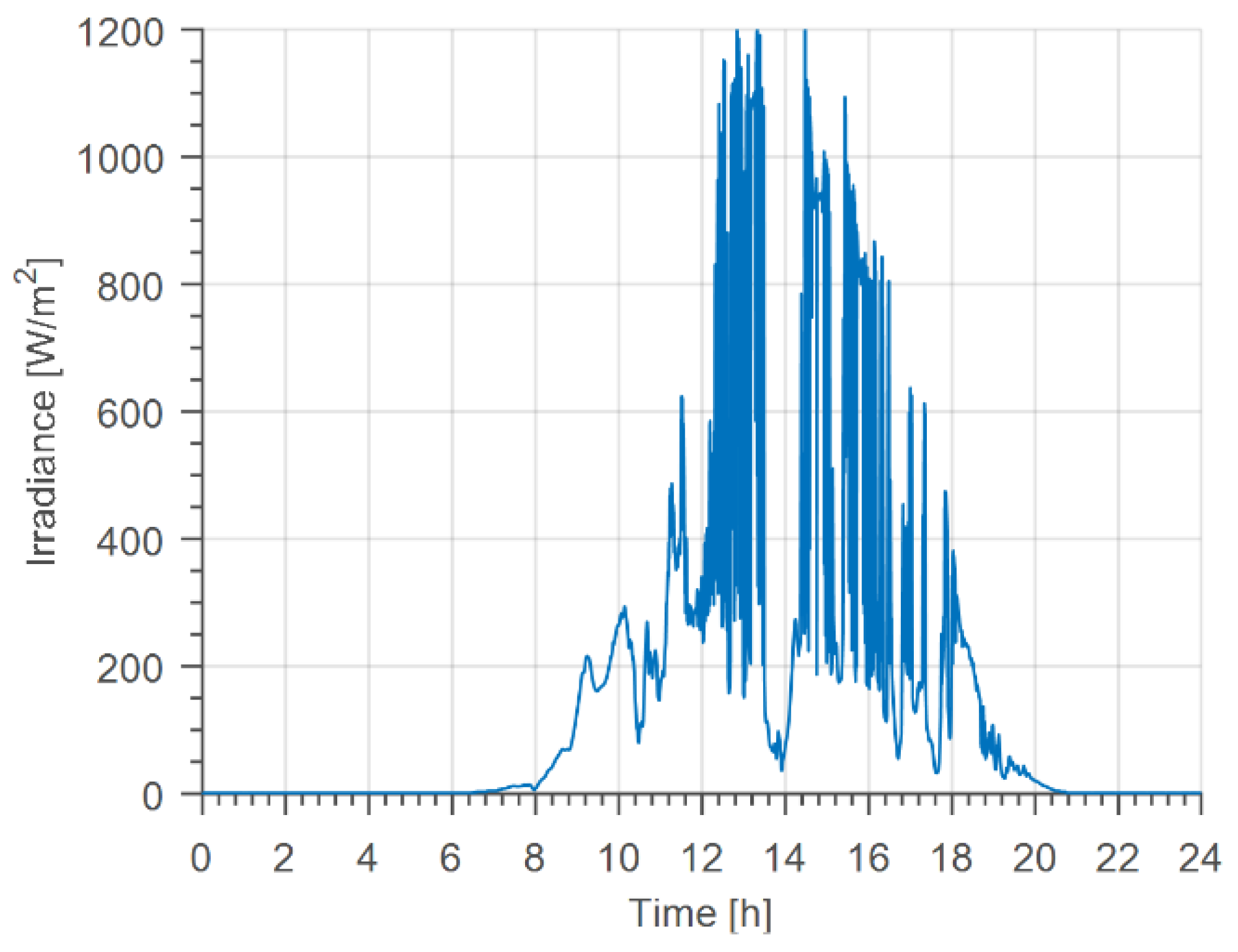
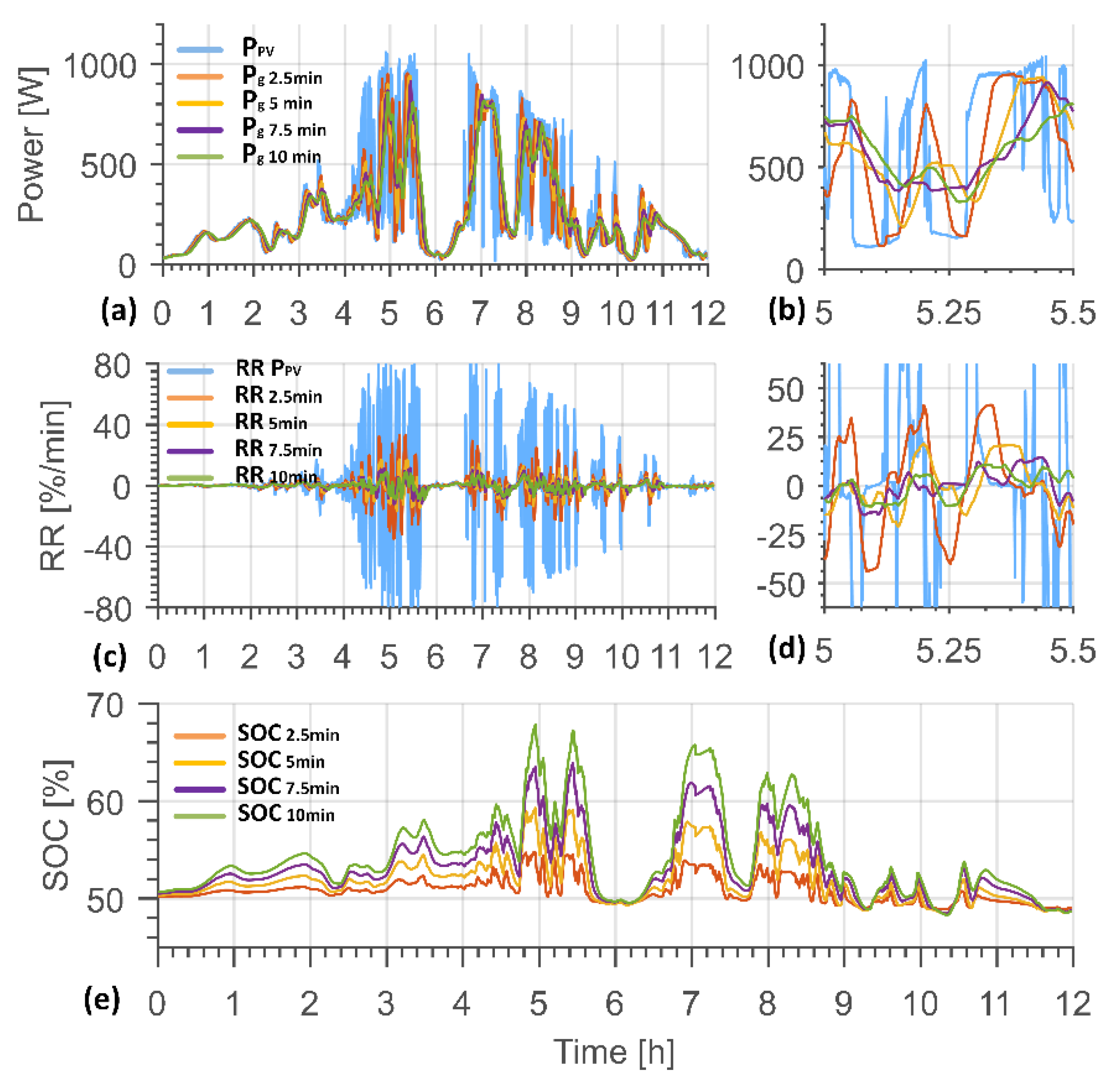
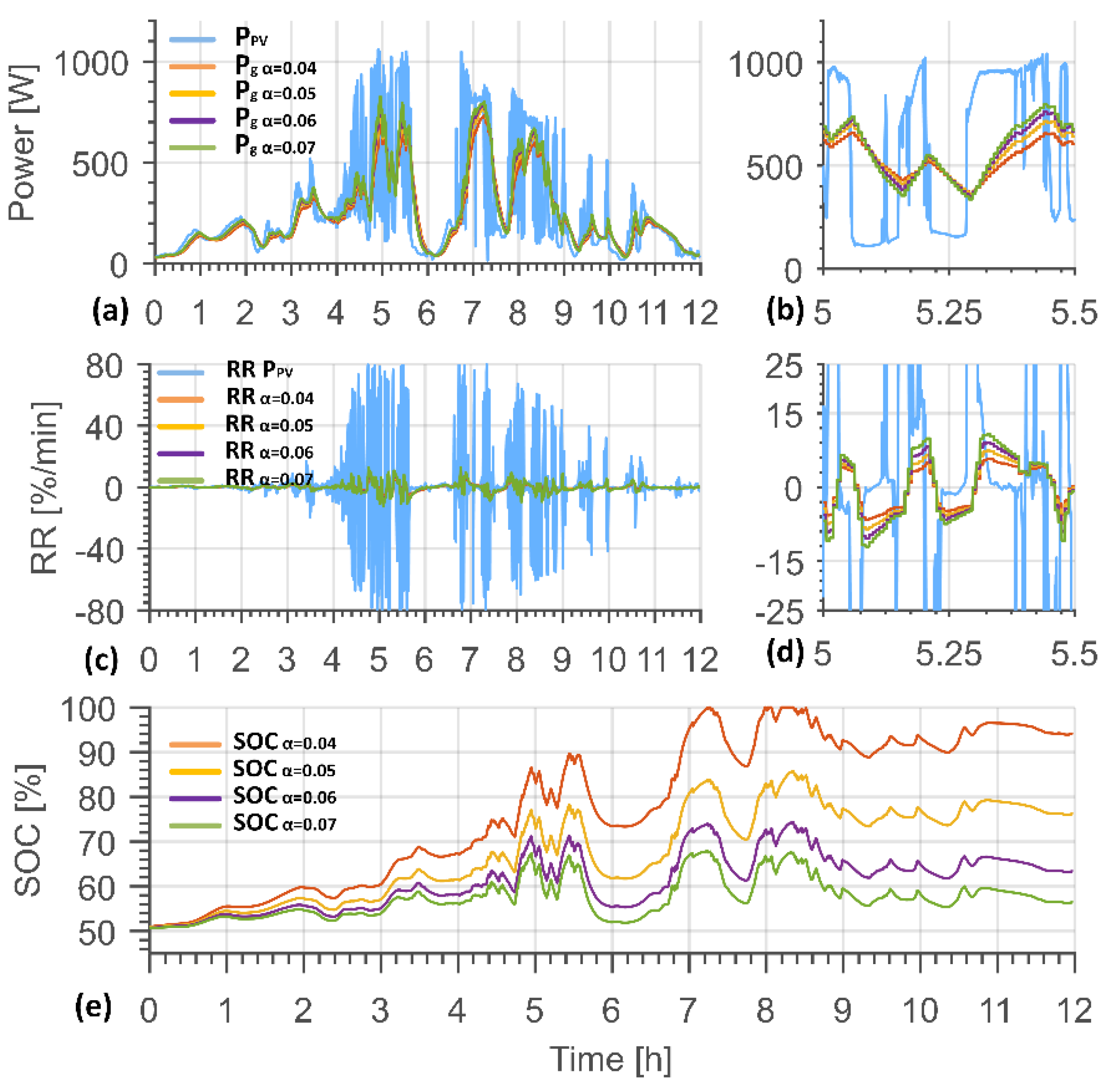
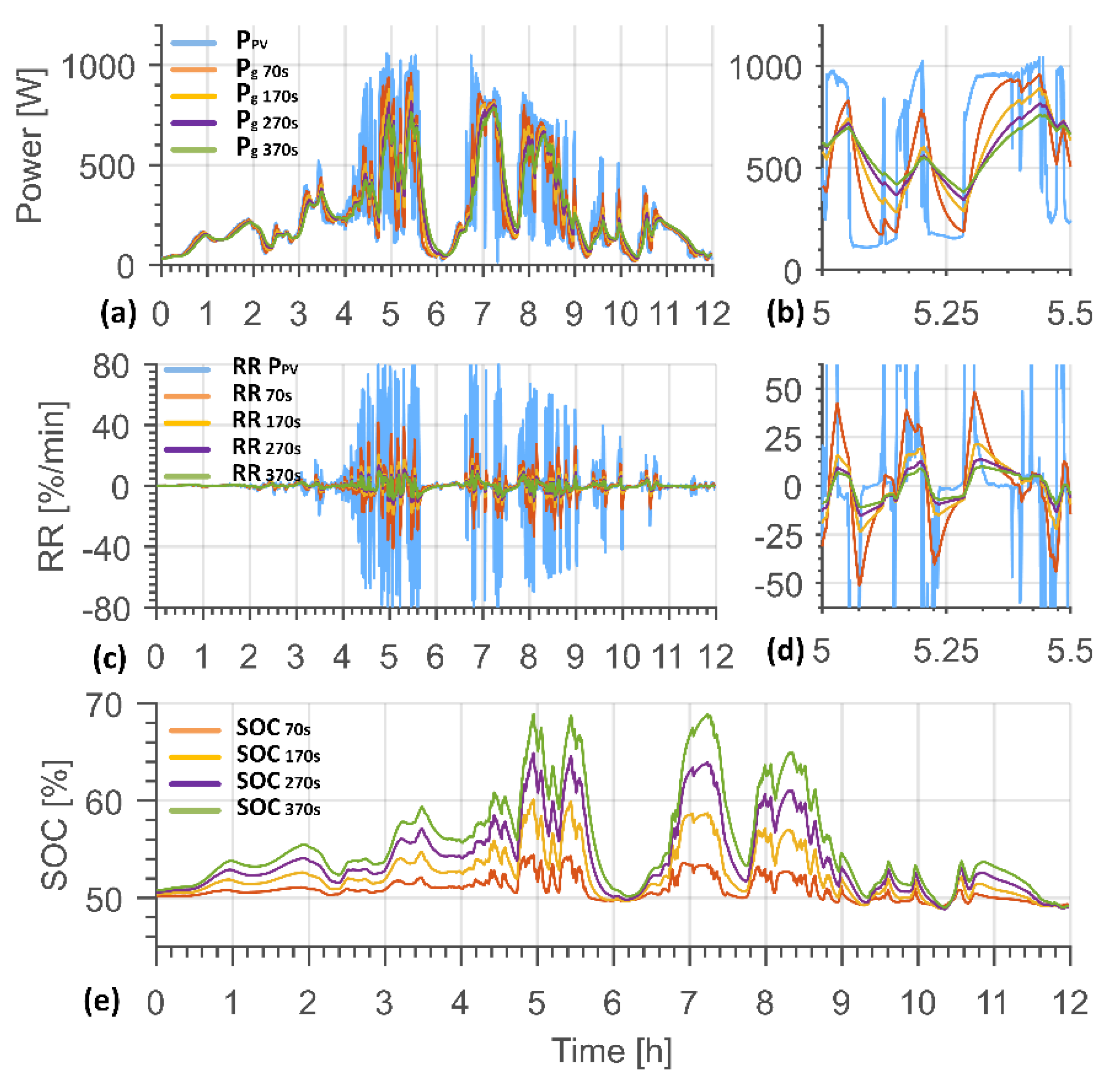
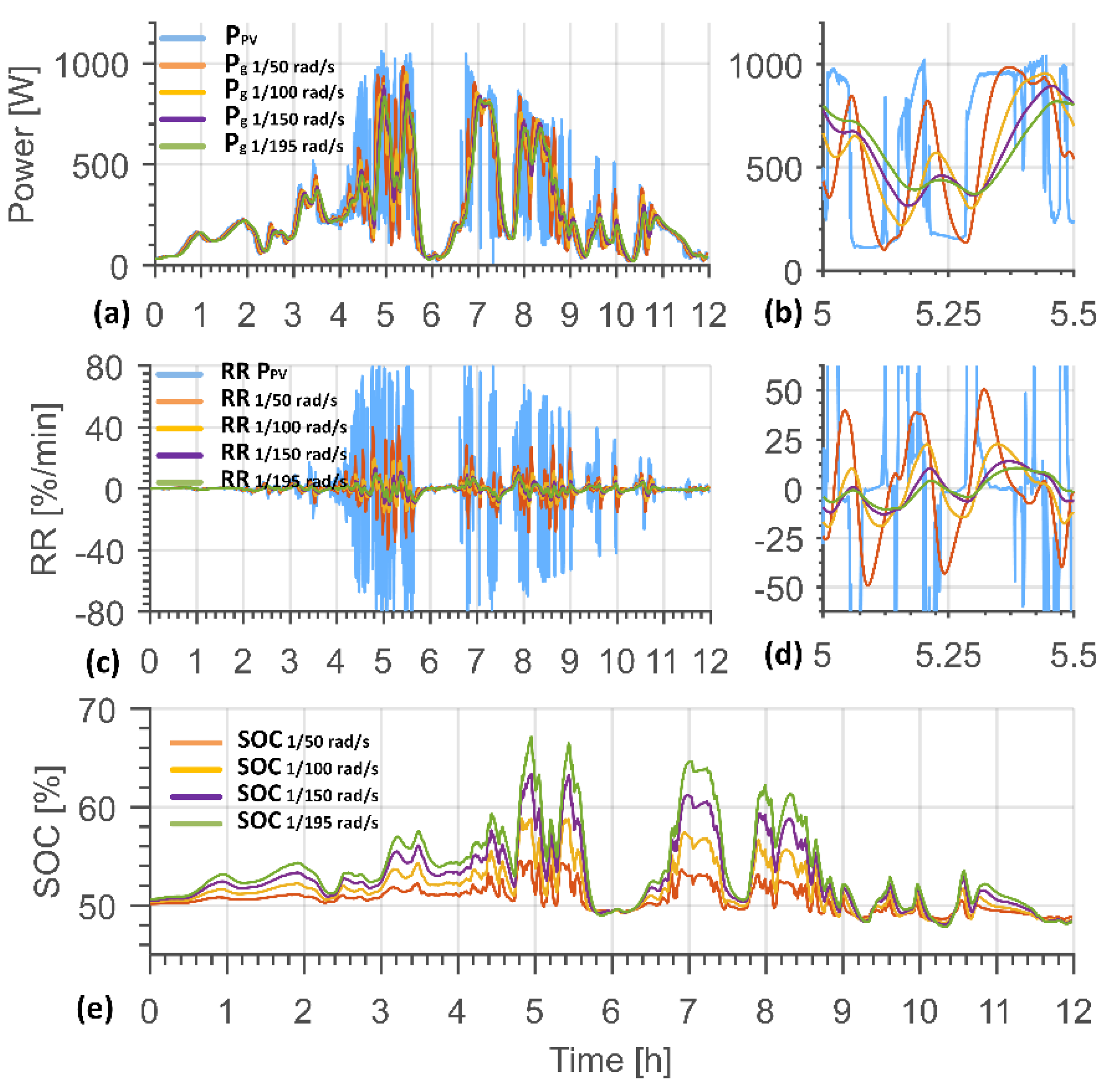
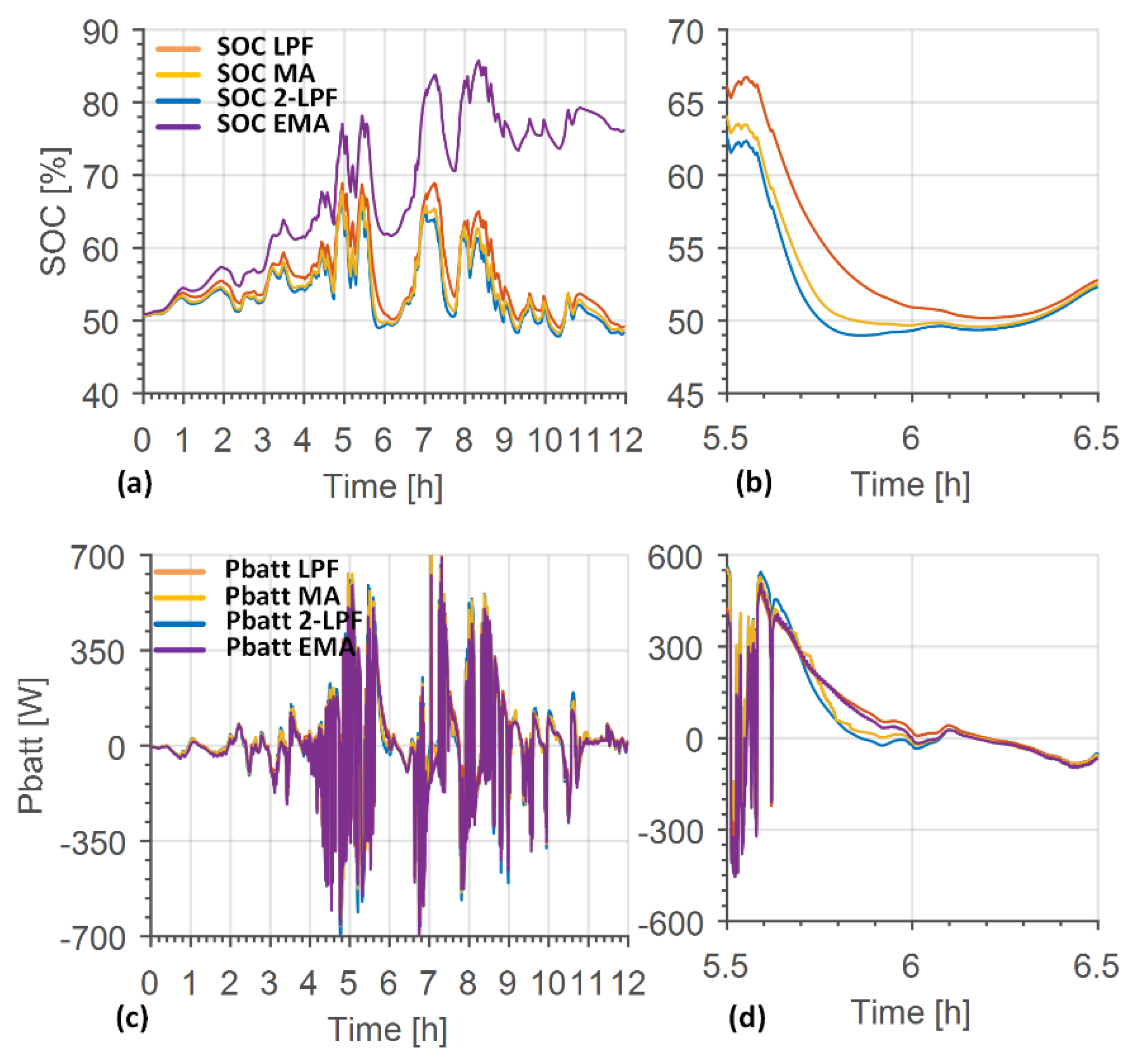
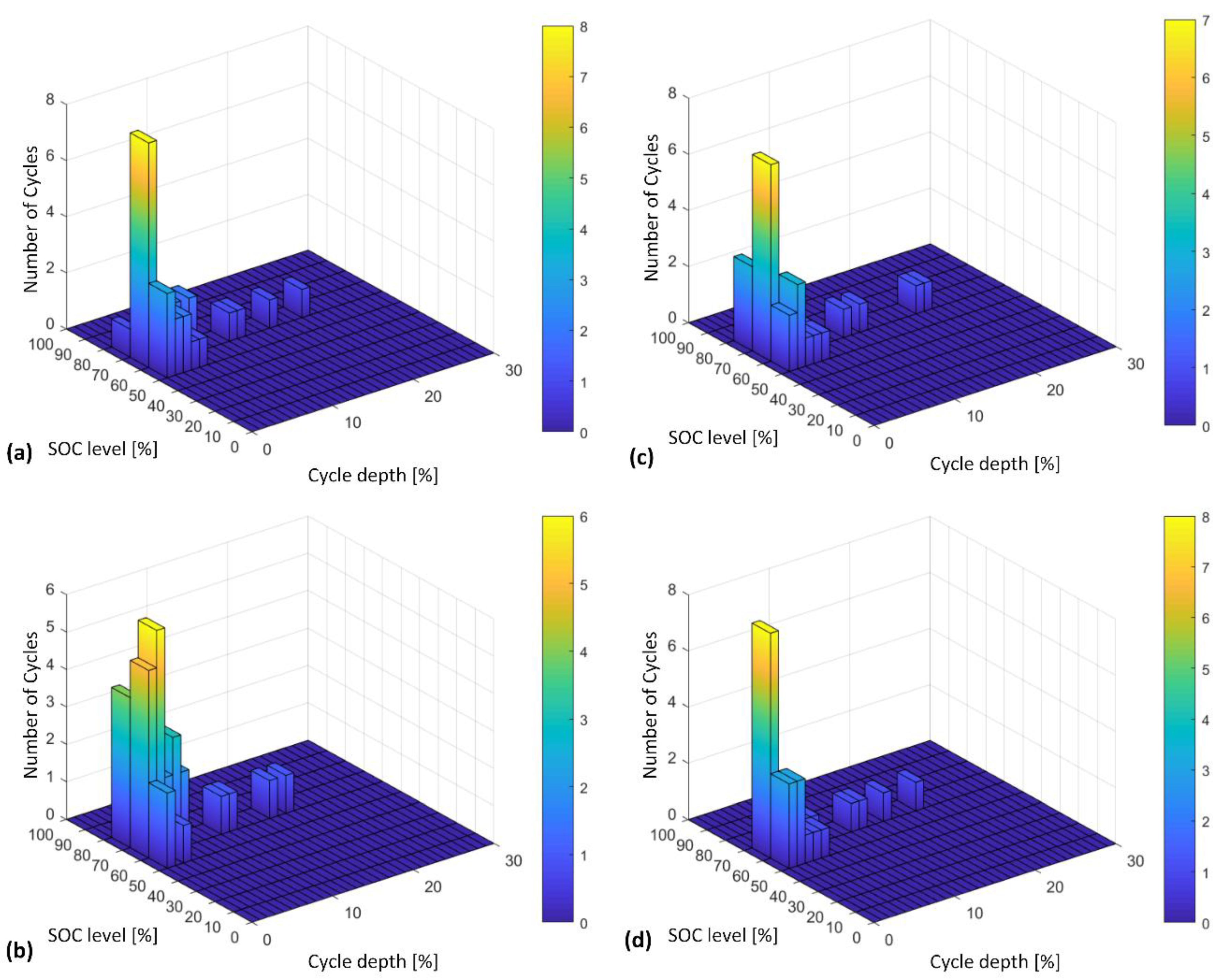
| Parameters | Li-Ion Battery |
|---|---|
| Battery constant voltage E0 [V] | 201.5 |
| Internal resistance R [Ω] | 0.255 |
| Battery capacity Q [Ah] | 1.5 |
| Polarization resistance/constant K [Ω or V/(Ah)] | 0.76 |
| Exponential zone amplitude A [V] | 8.21 |
| Exponential zone time constant inverse B [A/h] | 12 |
© 2019 by the authors. Licensee MDPI, Basel, Switzerland. This article is an open access article distributed under the terms and conditions of the Creative Commons Attribution (CC BY) license (http://creativecommons.org/licenses/by/4.0/).
Share and Cite
Martins, J.; Spataru, S.; Sera, D.; Stroe, D.-I.; Lashab, A. Comparative Study of Ramp-Rate Control Algorithms for PV with Energy Storage Systems. Energies 2019, 12, 1342. https://doi.org/10.3390/en12071342
Martins J, Spataru S, Sera D, Stroe D-I, Lashab A. Comparative Study of Ramp-Rate Control Algorithms for PV with Energy Storage Systems. Energies. 2019; 12(7):1342. https://doi.org/10.3390/en12071342
Chicago/Turabian StyleMartins, João, Sergiu Spataru, Dezso Sera, Daniel-Ioan Stroe, and Abderezak Lashab. 2019. "Comparative Study of Ramp-Rate Control Algorithms for PV with Energy Storage Systems" Energies 12, no. 7: 1342. https://doi.org/10.3390/en12071342
APA StyleMartins, J., Spataru, S., Sera, D., Stroe, D.-I., & Lashab, A. (2019). Comparative Study of Ramp-Rate Control Algorithms for PV with Energy Storage Systems. Energies, 12(7), 1342. https://doi.org/10.3390/en12071342








